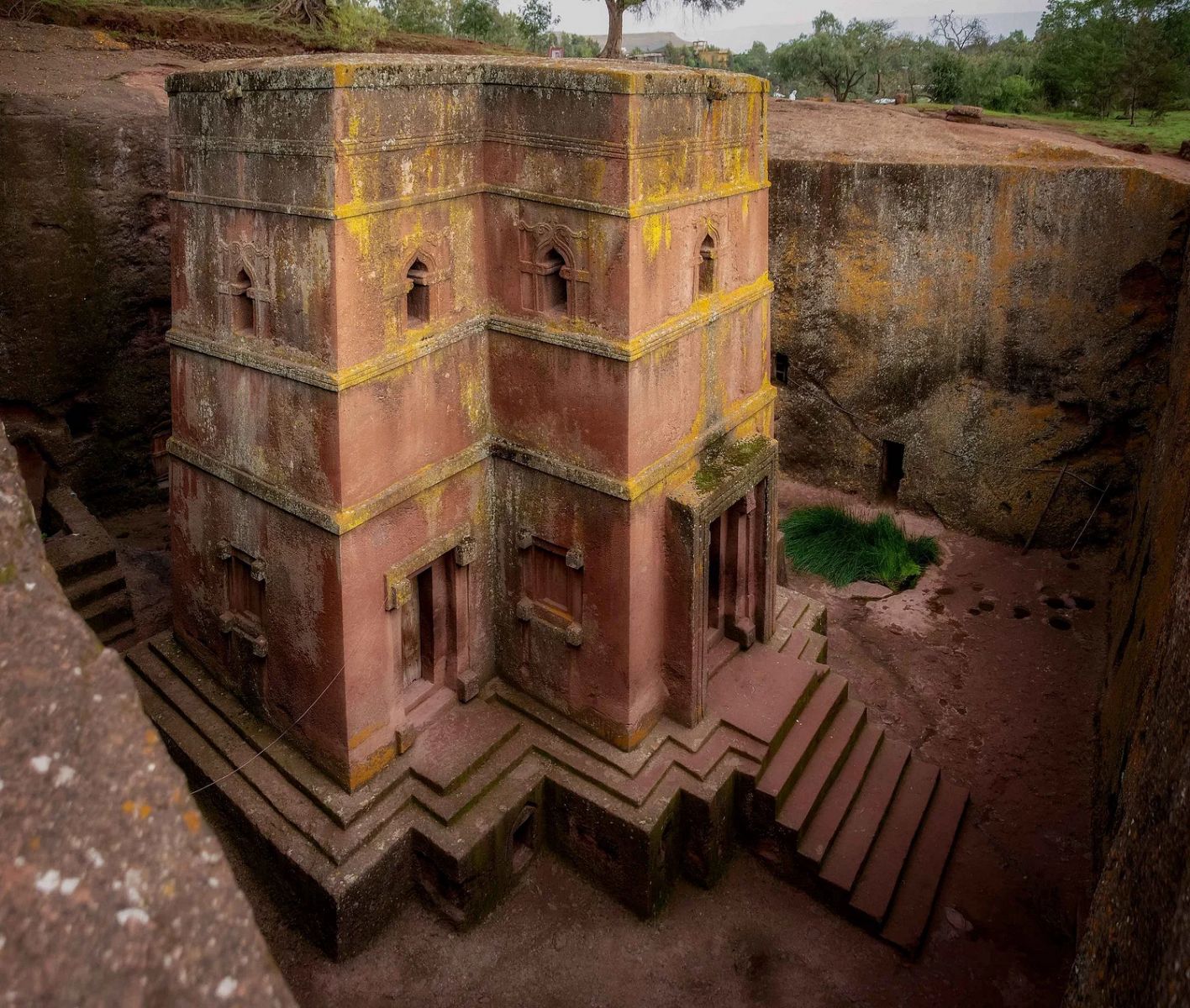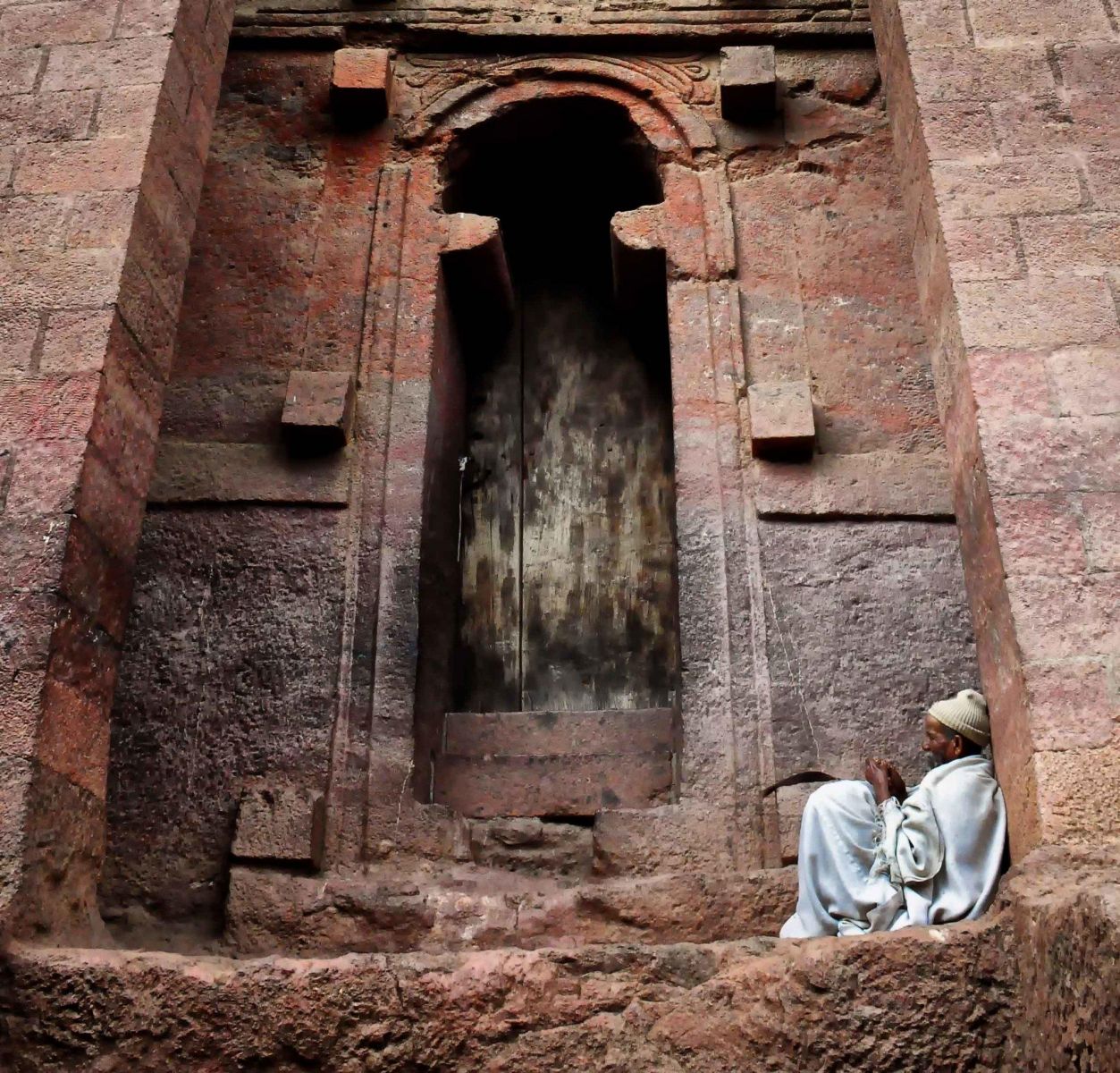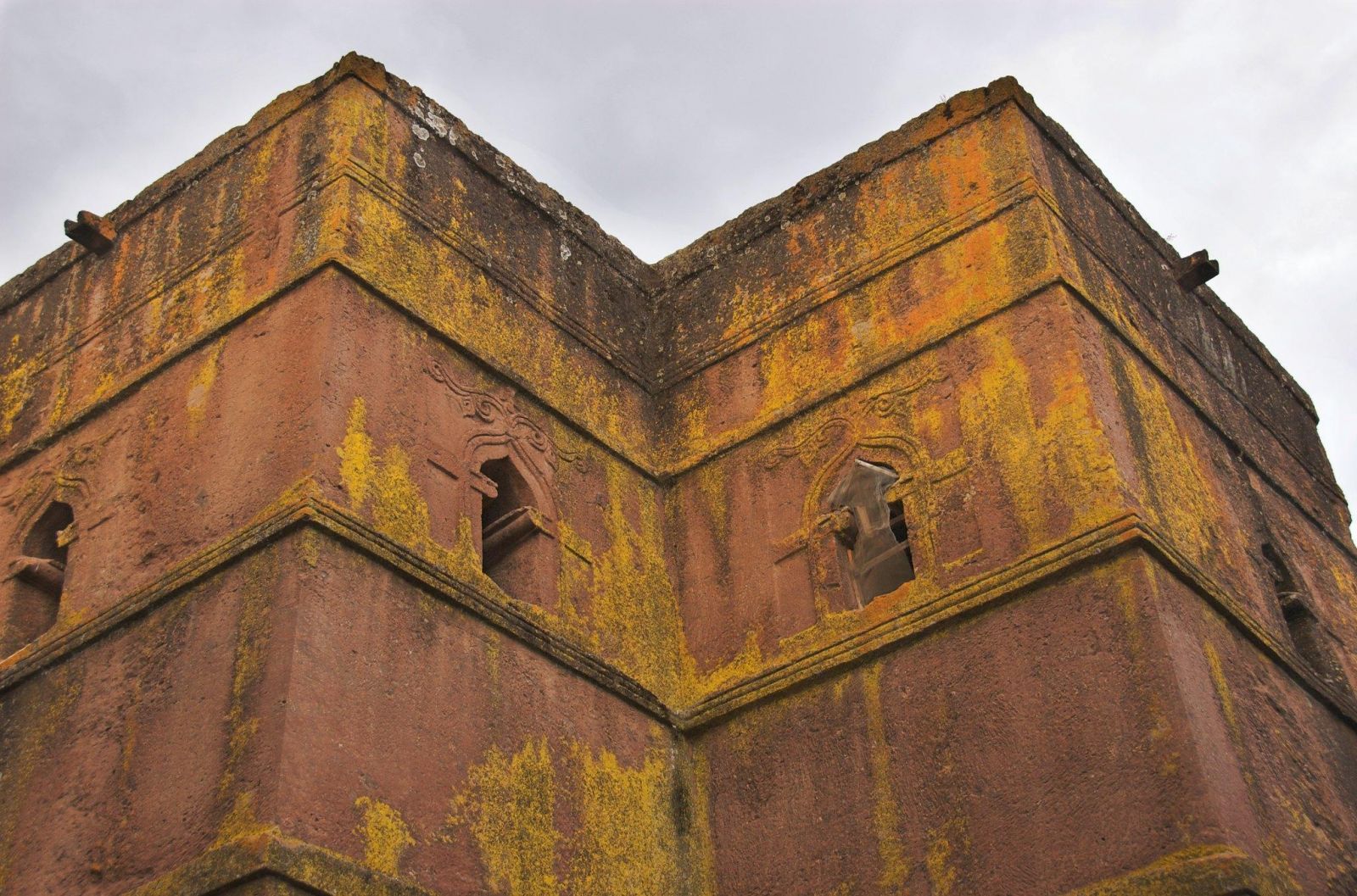The Church of Saint George in Lalibela
ArtWay Visual Meditation 14 April 2024
The Church of Saint George

Image by Rod Waddington. Source: Flickr
Not Made By Human Hands
by James Romaine
The rock-cut church of Saint George, located in Lalibela Ethiopia, is one the most amazing structures in the history of architecture. Carved directly out of the rock that surrounds it, this sanctuary astounds the imagination.
Still in liturgical use, Saint George is a pilgrimage destination for both tourists and devout believers. Visitors reach the church through channels cut into the rock and emerge at the entrance-level of the church.
Saint George was commissioned by the Ethiopian King Lalibela, who ruled between around 1181 and 1221. Today, the entire region is called Lalibela, after the celebrated king. King Lalibela is the most famous Ethiopian ruler from the Zagwe dynasty. In fact, he has officially been made a saint in the Ethiopian Orthodox Church. Saint George is King Lalibela’s enduring legacy.
How this structure was carved out of the living rock still remains a mystery. Some Ethiopian Orthodox believers credit the creation of this church to supernatural intervention. According to tradition, when the human workers put down their tools at the end of the day, angels picked up the tools and carved through the night.
To create this church, workers, either human or angelic, cut directly into volcanic material. As they were excavating down toward what would be the church’s so-called ground level, carvers cut in doors and windows. And they hollowed out the interior of this monolith. The church emerged, seemingly by miracle, from the rock.


For some modern sceptics, the suggestion that this implausible structure was miraculously carved by a team of angles might have the same charming incredulity as the fairy tale about the old shoemaker who received the magical aid of elves. However, we should not be too quick to dismiss the value that this creation narrative has for helping us understand what this church meant to King Lalibela and to countless Ethiopian Orthodox believers. If we consider the church of Saint George from a perspective of faith, from a perspective of belief in the presence and power of miracles, then perhaps this creation narrative is more than just a myth.
Saint George is a house of God that emerges from the rock, a material that had been present there since the Genesis creation. Standing outside of human time, this structure of faith appears to have been miraculously created.
If the design and carving of this sacred sanctuary is ascribed to the supernatural, this rock-cut church might be perceived as an architectural parallel to the icons of the Orthodox church, which are also believed to be sacred in origin. The belief in miraculously created icons, icons not made by human hands, has been central to the liturgical tradition of the Orthodox Church.
Even without ascribing the creation of Saint George to the participation of angels, conceptualizing this rock-cut church, in the spiritual context of miraculous icons, answers many of the questions concerning both its purpose as well as the highly unusual process that gave it form.
If King Lalibela’s faith proceeded from a liturgical practice that venerated sacred icons, then the church in which he worshiped also needed to be supernatural in design. By crediting the creation of this church to angelic labor, the Ethiopian Orthodox Christian proclaims it to be a sacred sanctuary. Fit to be the residence of the divine. A God, who cannot be constrained by human achievements, has ordained his own creation, the rock itself, as his residence.
Perhaps, the belief that the Church of Saint George was miraculously created consecrated the structure, in the spiritual imagination of the Ethiopian Orthodox Christian, for its liturgical purpose. The narrative that this structure was extracted from the living rock by angels unites its design and creation with its identity as the dwelling place of the uncreated God.
Even for those who might not fully embrace this creation narrative, standing before or within this magnificent structure, the beholder has a sense of being in the presence not of any human architect but of the divine creator of the rock itself.
*******
James Romaine is Professor of Art History in the Department of History & Philosophy at Lander University in Greenwood, SC, USA. He is a co-founder of the Association of Scholars of Christianity in the History of Art (ASCHA). His scholarship has recently been published in The Artistic Sphere, The Arts in Neo-Calvinist Perspective (IVP Academic, 2024) and Religion and Contemporary Art: A Curious Accord (Routledge, 2023). His videos can be viewed on YouTube at Seeing Art History, including a three-part series on the Church of Saint George at Lalibela in Ethiopia.
-
Historical Context, https://youtu.be/IuDv1T_ghJM
-
Form and Process, https://youtu.be/Dt83xTDAud8
-
Liturgical Purpose, https://youtu.be/PRcG58iBDok
*******
ART NEWS INTERNATIONAL
ECCE HOMO/BEHOLD THE MAN AT THE MUSEUM OF THE BIBLE
In February Ecce Homo/Behold the Man opened at the Museum of the Bible, the first exhibition from Bowden Collections at this wonderful museum.
Art Net covered the show and the Museum of the Bible also interviewed Sandra about her collection, her work as an artist, and information on the Ecce Homo/Behold the Man show at their museum. Click here to see that interview.
21 March ‘24 - 28 February ‘25 | Compton Verney Art, UK
For the first time in thirty years, a rare masterpiece will be reunited. Bringing together the central panel from The National Gallery of Scotland’s collection, with the original wings in Compton Verney’s collection, the magnificent Lamentation Altarpiece dated c. 1515, will take center stage in the Northern European collection of Compton Verney.
19 March - 30 June ‘24 | Charlotte, NC, USA
The Kunsthistorisches Museum Vienna’s 2024 spring exhibition is devoted to three pioneers of the Renaissance north of the Alps: Hans Holbein the Elder, Hans Burgkmair, and Albrecht Dürer. It offers an opportunity to experience fascinating works by these artists and to explore how Augsburg became the birthplace of the Northern Renaissance.
CALL FOR ARTIST COLLABORATORS:
Material Rendering of Imagery of 'Divine' and 'Faith' among Practicing Christian Adults with Artistic Skills
March - October 2024 | Cambridge, UK
This is an invitation for passionate visual artists with a Christian faith to collaborate on a research project run by the director of studies at the Faraday institute in Cambridge, Dr Pavlína Kašparová OP, that delves into the very essence of faith and the divine and how these concepts are expressed through art.
INAUGURAL MCDONALD AGAPE LECTURE IN THEOLOGY + BOOK PRESENTATION
9 July 2024, 6-8pm | London, UK
Neil MacGregor (former director of the National Gallery and British Museum) and Jonathan Ruffer (founder of The Auckland Project) discuss the role of museums, old and new, in curating the public understanding of Christianity and stimulating conversation about art and religion in a contemporary society. The lecture will be followed by a Book Launch: Theology, Modernity and the Visual Arts, eds. Ben Quash & Chloë Reddaway (Brepols), and a drinks and canapés reception for everyone attending.
REGENT COLLEGE SUMMER COURSE: BIBLE & CULTURE
23 June - 6 July 2024 | Woltersdorf, Germany
Co-presented by Regent College and IFES Graduate Impact, Bible and Culture is an opportunity to explore how God’s word speaks with clarity and relevance to the big issues of our time.
Bible and Culture 2024 will take place at a beautiful education centre in Woltersdorf, just outside Berlin. Come for one or two weeks (your choice!) for week-long courses on a variety of topics.
See for more exhibitions, symposia and lectures, podcasts, videos, books, ArtWay news and more here
ARTWAY: OPENING EYES, HEARTS AND MINDS






